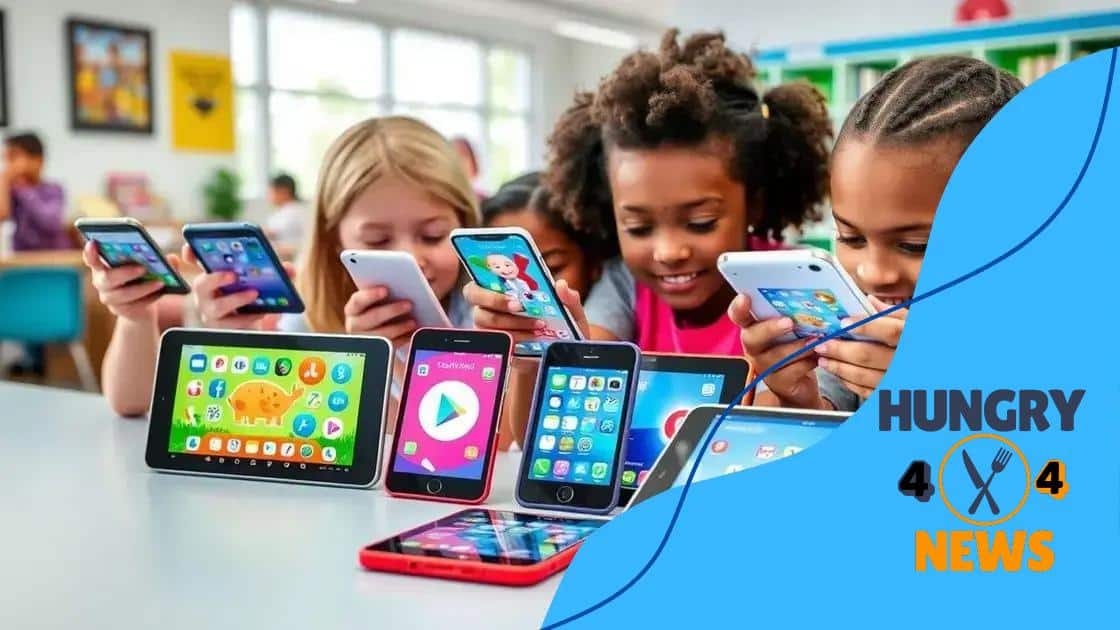Mobile learning applications for students of all ages

Mobile learning applications for students of all ages provide flexible, personalized, and interactive learning experiences, enabling access to educational resources anytime and anywhere, ultimately enhancing engagement and collaboration.
Mobile learning applications for students of all ages are transforming how education is delivered and accessed. Imagine having the world of knowledge right in your pocket, anytime and anywhere. Curious about how these apps can change your learning experience?
Understanding mobile learning applications
Understanding mobile learning applications is essential for students today. These apps are changing how we learn and interact with educational materials. By utilizing mobile technology, learners can access information and resources anytime, anywhere.
There are several key features of mobile learning applications that make them effective. These features are designed to improve learning outcomes and engage students more deeply.
Key Features of Mobile Learning Applications
Some important aspects of mobile learning apps include:
- Accessibility: Students can easily access learning materials from their devices.
- Interactivity: Engaging content encourages participation and keeps learners motivated.
- Flexibility: Students can learn at their own pace and choose when to study.
These attributes help create a personalized learning experience. Furthermore, mobile learning fosters collaboration among students. Many applications allow users to share resources and communicate with peers in real-time.
As education evolves, mobile learning apps are becoming more sophisticated. These tools often incorporate adaptive learning technologies, which can assess a student’s progress and adjust the content accordingly. This personalization enhances the learning journey, making it more relevant and effective.
The appeal of mobile learning applications extends beyond traditional students. Lifelong learners and working professionals also benefit from these tools. They can pursue new skills and knowledge on their own schedule, leading to continuous growth and development.
Ultimately, recognizing the value of mobile learning apps can lead to innovative educational experiences that reach a wider audience. With their user-friendly design and modern features, these applications are transforming the landscape of education.
Key benefits of mobile learning for students
Key benefits of mobile learning for students are shaping the future of education. Mobile learning applications offer numerous advantages that elevate the learning experience and accommodate different learning styles.
One major benefit is flexibility. Students can study whenever and wherever they choose, fitting education into their busy lives. This leads to increased motivation and engagement, as learners can balance their responsibilities while accessing valuable information.
Enhancing Student Engagement
Engagement is crucial for effective learning, and mobile learning apps excel here. These applications often include interactive content such as quizzes and videos that make studying more enjoyable.
- Interactive resources: Games and simulations can make complex subjects easier to understand.
- Real-time feedback: Immediate assessments help students identify areas for improvement quickly.
- Peer collaboration: Students can connect and work together, enhancing their learning experience.
Another significant benefit is personalization. Mobile learning applications can adapt to individual learning paces, allowing students to progress according to their capabilities. This leads to greater mastery of subjects and reduces frustration.
Moreover, mobile learning supports lifelong learning. Students of all ages can continue to develop skills and knowledge at their own convenience, fostering a culture of ongoing education. Whether they seek new hobbies or professional development, mobile learning makes it accessible.
Lastly, the cost-effectiveness of mobile learning is appealing. Many applications are free or low-cost, providing high-quality resources without the need for expensive textbooks or courses. This democratizes education, allowing more people to benefit from learning opportunities.
Popular mobile learning apps available today

Popular mobile learning apps available today are transforming education by making learning more accessible and engaging. These applications cater to diverse learning styles and age groups, offering students the ability to learn at their own pace.
One of the most recognized apps is Duolingo, which focuses on language learning. Its game-like interface makes practicing a new language enjoyable. Students can start with basic vocabulary and progress to more complex sentences, all while keeping track of their progress.
Other Notable Mobile Learning Apps
Additionally, Khan Academy provides a wealth of resources on various subjects, from math to history. It includes instructional videos and practice exercises, allowing students to deepen their understanding of topics at any time.
- Quizlet: An app that helps students reinforce their knowledge through flashcards and quizzes.
- Coursera: Offers online courses from prestigious universities, enabling learners to gain skills in numerous fields.
- Edmodo: A social learning platform that connects students and teachers, fostering collaboration and communication.
These apps illustrate the power of mobile learning in today’s educational landscape. They make content engaging, provide instant feedback, and allow for peer interaction, which can enhance the learning experience.
As technology continues to evolve, newer apps are emerging to meet the needs of students. Apps like ClassDojo help teachers manage classrooms while keeping parents informed about their children’s progress. Each application plays a vital role in supporting different learning environments.
With countless options available, students can choose apps that best suit their individual learning goals and interests. This personalization is key to effective learning in a mobile-first world.
Tips for effectively using mobile learning applications
Tips for effectively using mobile learning applications can significantly enhance the learning experience. By applying the right strategies, students can maximize their engagement and retention of information.
First, it’s essential to set clear goals while using these applications. Define what you want to achieve. This clarity will give direction and motivation as you work through the material.
Creating a Productive Learning Environment
Along with goal setting, creating a dedicated study space is crucial. Find a quiet and comfortable place where you can focus without distractions. This setting will help you immerse yourself in the learning process.
- Limit distractions: Silence notifications and keep your study space clutter-free.
- Use headphones: Listening to calming music or white noise can help maintain concentration.
- Set a schedule: Allocate specific times for learning, making it part of your routine.
Another important tip is to actively engage with the content. Rather than passively consuming information, interact with the material. Take notes, summarize key points, and participate in quizzes or discussions. This active involvement can reinforce your understanding.
Utilizing the social features of learning apps is beneficial too. Connect with peers or study groups to share insights and support each other. Collaborative learning can deepen comprehension and make studying more enjoyable.
Lastly, remember to track your progress. Many mobile learning applications offer progress reports and achievements. Celebrating small milestones can keep you motivated and invested in your learning journey.
By following these tips, students can use mobile learning applications more effectively, leading to improved outcomes and a richer educational experience.
Future trends in mobile learning technology
Future trends in mobile learning technology are exciting and impactful. As technology continues to evolve, mobile learning applications are expected to incorporate more advanced features that enhance the educational experience.
One significant trend is the use of artificial intelligence (AI) in mobile learning apps. AI can personalize learning experiences by adapting content to meet individual student needs. This means that learners can receive customized lessons based on their pace and understanding.
Augmented and Virtual Reality
Another promising area is the integration of augmented reality (AR) and virtual reality (VR)
Additionally, mobile learning is likely to incorporate more social learning features. These features encourage collaboration among students, allowing them to share insights and resources. Combining peer interactions with mobile learning can enhance critical thinking and problem-solving skills. There is also a growing emphasis on data analytics in education. Mobile learning applications will utilize analytics to assess student performance and offer targeted support. Educators will be able to track progress and intervene when necessary, leading to better educational outcomes. Lastly, the continued expansion of multi-language support in mobile learning apps aims to create inclusive learning environments. This ensures that learners from diverse backgrounds can access education in their native languages, improving comprehension and engagement. Mobile learning applications are reshaping how students learn by offering flexibility, personalization, and engagement. As we look to the future, these apps will continue to evolve with advances like artificial intelligence and virtual reality. Emphasizing collaboration, data analytics, and multilingual support will make education more inclusive and effective. By embracing these trends, learners of all ages can thrive in a dynamic educational landscape, preparing them for success in an increasingly digital world. Mobile learning applications are tools that allow students to learn on their smartphones or tablets, providing access to educational content anytime and anywhere. Using mobile learning apps gives you the flexibility to study at your own pace, engage with interactive content, and access a wide range of resources tailored to your learning needs. Yes, there are various apps designed for specific subjects, including language learning, math practice, and even science exploration, each catering to different educational goals. Absolutely! Many mobile learning apps include features that allow students to collaborate with peers, share insights, and participate in discussions, enhancing the learning experience.
FAQ – Frequently Asked Questions About Mobile Learning Applications
What are mobile learning applications?
How can I benefit from using mobile learning apps?
Are there specific apps for different subjects?
Can mobile learning apps offer collaboration features?





